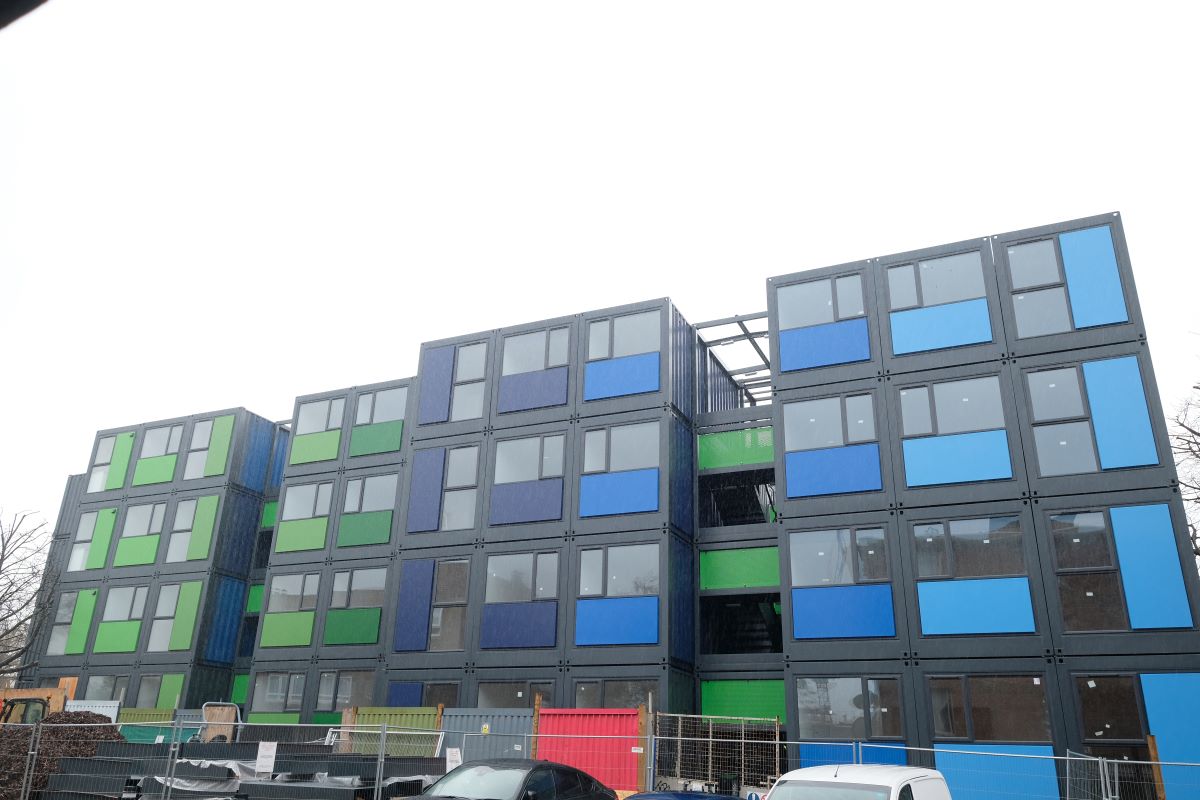These micro flats are popping up all over, but are they really a good solution?
If you’ve strolled through London lately, you may have noticed a modern, brightly coloured building in what used to be an underused lot in Ealing. Or the one that preceded it in Hanwell.
The finished products look almost like a stack of shoeboxes, and they’re cheap and quick to manufacture. The size of the units ranges from 12 to 36 square metres.
These construction projects, made by stacking shipping containers together and outfitting them with narrow kitchens, bedrooms, and bathrooms, are popping up all over the place as an answer to Britain’s rising levels of homelessness.
True, they get rough sleepers in off the streets and offer homeless families more privacy and independence than shelters can. But they’re far from permanent living arrangements.
Packing families into flats no wider than the width of a lorry cannot be a long-term solution. Unfortunately for many who live there, that’s exactly what it’s become.
Ongoing Emergency Housing
These cramped living quarters have been billed as temporary emergency housing. But some families have been living in them for more than 18 months, with no other options on the horizon.
While the residents themselves may not change throughout the year, the temperature inside the units certainly does. In the winter, the shipping container offers little insulation, though the apartments do have heat. The situation is worse in the summer when the record-breaking temps we’ve been seeing heat up the metal walls of the container and make the interiors virtually unlivable.
Some residents have taken to sleeping outside on the walkways during hot summer nights because their units are too unbearable. A bit ironic.
The cramped quarters and lack of amenities like wifi also make life difficult for residents who are housed here long-term.
Un-Affordable Housing
At this point, you may think the situation doesn’t sound ideal, but it’s certainly better than living on the streets. And, with the discounted rates residents are paying, they can’t expect everything.
Well, the rent is actually about on par to local private rents at £270 per week. Based on the size of the units, that works out to as much as £90 per square metre, per month. Regulations state than in order to be considered “affordable housing”, rent costs must be capped at no more than 80% of the cost of local private sector rent. Needless to say, for many these “affordable” prices are still nowhere near truly affordable.
For many residents, the majority of their rent is covered by housing benefit. However, residents can still be evicted if they fall behind on rent – a situation likely familiar to many of them, since evictions are the inciting event for more than 32% of homelessness across England and 39% within London. That number has been steadily growing over the years and is now the single biggest cause of homelessness in England.
Imagine being forced out of your home, often at no fault with the soon-to-be-abolished section 21 notice, only to be put up in temporary housing and evicted from there, too.
Desperate Decisions
It’s easy to see how we got to this point.
With more families stacking up on mile-long waitlists and less social housing being built, something had to give. The ease of assembly and relatively low cost of these shipping container buildings makes them an attractive choice for councils.
The typical building cost for each one of these units is about £35,000 total. And a whole stack can be assembled and ready to take on residents in as little as 24 weeks. This is a much easier sell than the price tags and timelines that usually come with traditional construction.
Unfortunately, we’ve got what we’ve paid for.
Stopgap or Full Stop?
Shipping container homes are not an ideal solution. The lack of space, wifi, cooling, and adequate heating all make them inhabitable longterm. Still, it’s difficult to definitively say whether they’re a step forward or back.
It depends on how they’re used.
These homes are designed to be a stopgap measure – a way to house more families and keep them off the streets until a more permanent housing solution can be found. If they were consistently used this way, they could be a great thing.
But in many cases, that permanent solution isn’t coming through.
Families are languishing for months or years in these apartments that are really only meant for short-term accommodation.
From the amount of self-congratulatory back-patting that goes on each time one of these buildings goes up, it’s clear authorities see these projects as more of a viable solution than they really are.
That’s when the stopgap turns into the full stop, and that’s when it becomes dangerous.
When people are warehoused away in neat little boxes and forgotten, which is how many residents of these shipping container projects feel, no one is really being helped. They’ve just been moved out of sight, and out of sight is out of mind.
The underlying problems aren’t being solved. They’re only becoming less visible. Less visibility leads some people to believe the problems have been solved. Therefore, no more thought or work needs to go into it. That’s a big problem.
Shipping container homes are adequate for a short time only. They’re meant to buy families more time to get into proper housing before they hit the streets.
But when proper housing doesn’t come, or when it simply isn’t being built because it’s so much cheaper and easier to build these substandard shipping container blocks, they become a prison.
Shipping container homes are meant to be a steppingstone to permanent housing, a pathway. But too often, they become the end of the line.












